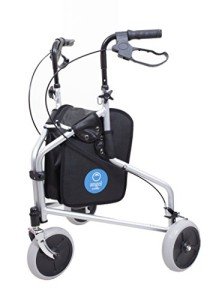A Retrospective How People Talked About Rollator Walker 20 Years Ago
The Comprehensive Guide to Rollator Walkers
As the population ages, the demand for mobility aids like rollator walkers has surged. These walkers supply stability, support, and freedom of motion for people dealing with mobility issues, be they temporary or chronic. Understanding the types of rollator walkers offered, their benefits, features, and how to choose the best one can considerably improve the lifestyle for both the user and their caretakers.

What is a Rollator Walker?
A rollator walker is a mobility aid created to assist people maintain their self-reliance while walking. It features a frame with 4 wheels, hand brakes, and a seat, making it appropriate for users needing extra assistance without the complete constraints of conventional walkers.
Key Features of Rollator Walkers
Rollator walkers come geared up with numerous functions developed to improve user experience. Here are a few of the most common features:
- Four-Wheel Design: The most appreciable function is its four wheels, which enable smoother shifts over numerous terrains.
- Cushioned Seat: Many rollators featured a built-in seat, offering a resting point for users who might tire easily.
- Hand Brakes: Most models have hand brakes that permit users to secure the walker in place when sitting or browsing unequal surface areas.
- Storage Options: Many rollators include a basket or storage pouch for personal items, such as water bottles or small bags.
- Adjustable Height: Users can customize the height of the manages for ideal comfort and posture.
Benefits of Using a Rollator Walker
Rollator walkers offer numerous advantages. They can substantially enhance mobility and safety for users. Here are some essential benefits:
- Enhanced Stability: With four wheels and a sturdy frame, rollators supply remarkable stability compared to standard walkers.
- Practical Seating: The integrated seat permits users to rest whenever needed, promoting longer trips without tiredness.
- Increased Confidence: The included support can assist users feel more safe and secure throughout walks, which can cause longer ranges took a trip.
- Improved Posture: With adjustable heights, users can preserve a more natural posture while walking, which can reduce discomfort.
- Independence: Rollators enable lots of people to gain back or preserve self-reliance in their everyday activities.
Types of Rollator Walkers
Rollator walkers come in different designs and variations to fulfill specific needs. Here are a couple of common types:
| Type | Description |
|---|---|
| Requirement Rollator | Standard four-wheeled model created for indoor and outdoor use. |
| Junior Rollator | A smaller variation tailored for much shorter individuals or children. |
| Sturdy Rollator | Built to accommodate bigger body weights and offer extra stability. |
| Three-Wheel Rollator | Compact style ideal for navigating tight spaces. |
| Rollator with Seat | Functions an integrated seat for resting during use. |
| Rollator With Storage (http://140.114.135.53/) | Features detachable baskets or pouches for easy transport of individual items. |
Choosing the Right Rollator Walker
Picking the ideal rollator walker includes thinking about user needs, preferences, and physical requirements. Here are some aspects to think about:

- User Height and Weight: Ensure the walker can support the individual’s weight and can be adjusted to their height.
- Terrain: Consider where the walker will mostly be utilized. Detachable wheels can assist move efficiently over rough terrains.
- Storage Needs: Determine if extra storage area is essential for the user’s day-to-day needs.
- Mobility: If frequent transportation is essential, lightweight models or those that fold for easy storage must be preferred.
- Budget: Prices can vary considerably; guarantee the chosen walker provides value without sacrificing quality.
Maintenance of Rollator Walkers
Correct upkeep can improve the life-span of a rollator walker. Here are some tips for keeping it in excellent condition:
- Regular Check-ups: Periodically check brakes and wheels for wear and tear.
- Clean the Walker: Use a mild cleaning agent and fabric to clean down surfaces and eliminate dirt.
- Look For Loose Parts: Tighten any screws or bolts that might end up being loose with routine use.
- Replace Parts as Needed: Wheels, hand grips, and brakes can wear out and may need replacement for maximum performance.
FAQs About Rollator Walkers
Q1: What is the average weight limitation for a rollator walker?A: Most basic rollator walkers support weights in between 250 to 300 pounds, while durable models can accommodate as much as 500 pounds. Q2: Can rollator walkers be used outdoors?A: Yes, lots of rollatorsare created for outdoor use. Those with
larger wheels and robust frames are especially fit for uneven surfaces. Q3: Do rollator walkers include warranties?A: Many producers provide service warranties ranging from 1
to 5 years on the frame and parts, guaranteeing resilience and user complete satisfaction. Q4: How do I properly adjust a rollator walker?A: Adjust the deals with to a height that enables the user to stand upright with
elbows somewhat bent when holding the deals with. Q5: Can
I use a rollator walker for rehabilitation?A: Yes, rollators are often utilized in rehab settings to improve walking self-confidence and mobility
after injuries or surgical treatments. Rollator walkers
are vital tools that supply improved mobility and independence for numerous people. By understanding the types, benefits, and correct usage of rollator
walkers, users can make informed choices that best suit their lifestyle and requirements. Whether recovering from an injury or managing a long-lasting condition, a rollator walker can make a considerable difference in the lifestyle, allowing individuals to restore their liberty and confidence while moving about the world.


